#Dobhar-chú
Text

These deadly beasts are sometimes believed to live in pairs. Should the one hunting be killed it will release a whistling sound that rings out to its mate, beckoning them to come take vengeance.
#BriefBestiary#bestiary#digital art#fantasy#folklore#legend#dobhar-chú#dobarcu#anchu#doyarchu#king otter#irish crocodile#irish folklore#irish legend#monster#beast#river monster#lake monster
47 notes
·
View notes
Photo

Fifth day of Cryptober! The Dobhar-chú! Thank you to everyone who stopped by the stream, the video will go up on Youtube tomorrow~!
Previous Day || Next Day
The Cryptober List
Commissions are open! || Support me on Patreon! || Watch me on Twitch!
#cryptid#The Dobhar Chu#Dobhar-chú#cryptober#cryptober2022#drawtober#sketchtober#illustration#artists on tumblr
6 notes
·
View notes
Text
Me remembering learning about the Dobhar-chú from my mom; and thinking about how that should have terrified me but instead I was like puppy and otter 🥺🥺
1 note
·
View note
Text

guess who's late for day 2!! and 3!! i'll catch up this weekend :D
anyways this is my newest oc, Fionn. he's from a setting where mythical creatures and anthropomorphic animals coexist, but only the mythical creatures can see each other's true forms. Fionn is a Dobhar-Chú, but to non-mythics he just looks like a massive leucistic otter. he's the gym teacher at small elementary school, and is bitter exes with the swim coach (who is an each-uisce)
#digital art#ocs#oc:fionn#bweirdoctober#i refuse to stop even if im late. idc!!#i can group day 3 and 4 prompts together i think#for the new ppl who missed hound ledger: Dobhar-Chú are otterish doggish irish folklore creatures#they have white pelts with black tipped ears and black crosses on their backs#they lurk in lakes and pull people in and murder the hell out of them
53 notes
·
View notes
Text
"Haha otter Neuvillette" you jest, and yet
Otters do actually hold significance in plenty of myths and folklores. Including those from the British Isles.
So. Otter Neuvillette might actually have weight. It's unlikely, but not as unlikely as one would think. Do with that what you will usehwbbsb
#and i don't mean dobhar-chú#other than that#otters seem to be portrayed positively#still dbshwhwbsbh#that guy turning out to be a little cute creature is sgsg#i love it#genshin impact#genshin crack#genshin spoilers#genshin speculation#genshin neuvillette
39 notes
·
View notes
Photo

Commission for @rhoga of a Dobhar-Chú, a giant otter (or otter-dog, or dog-fish) of Irish folklore.
230 notes
·
View notes
Text
since i have the power of polls i must ask. friends:
#cryptid#cryptids#cryptozoology#anyway yall. i put the classics plus some of my favorite lesser known#personal
151 notes
·
View notes
Photo

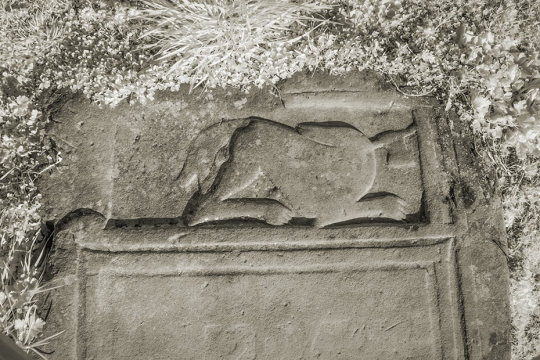
The Dobhar-chú [Irish folktales]
The waters of Glanade Lake, situated in Ireland, are home to a species of monstrous otters known as the Dobhar-chú, according to Irish folklore. That name literally translates to ‘water-hound’ and it was an old Irish term for otters.
In one particular version, it is said that when a regular (non-magical) otter has seven children, its seventh cub will become a Dobhar-chú. Although usually described as resembling a common otter in appearance, there is at least one variant of the story in which the Dobhar-chú had a sharp horn protruding from its forehead. One important characteristic is that their bodies were protected by a potent enchantment that rendered the creatures immune against attacks from any weapon. There was only one unprotected weak point, which was a small spot located under the breast of the animals. The only way to kill a Dobhar-chú is by attacking that spot.
In modern interpretations, the creature is most commonly depicted as either a regular otter or an otter with some monstrous characteristics.
The area surrounding Glenade Lake has a local myth about these creatures. As the story goes, a woman named Grainne lived by the lakeside. One day (in 1722) she went to wash her clothes in the water, but unknowingly encroached upon the territory of a Dobhar-chú while doing so. The creature killed the intruder without mercy.
Seeing that his wife hadn’t returned home, the husband – a brave fellow who went by the name of McLoghin – set out towards the lake and saw the otter-like creature resting on top of his wife’s corpse. Magical creature or not, this was a horrible sight and the man went back home to fetch his dagger. When he returned, the Dobhar-chú was still sleeping and he swiftly stabbed it in its weak spot.
With its dying breath, the creature let out a loud whistling noise. The man did not know what to make of this, but the elders of the village knew the ways of the fae, for they were wise and experienced. They told him that the creature had called upon the others, and advised the man to flee with great haste. Thus, the hero of the story gathered his horse and left the village together with a close friend. As the two men were fleeing, they noticed that a second otter was pursuing their horses with incredible speed. Try as they might, the men failed to lose their pursuer.
With no other option, the men halted their horses and stopped near a cluster of ruined walls. The creature ran between the legs of one of the horses and attempted to attack the men, but it was stabbed in its week spot and killed. In the version where the creature had a horn on its head, it impaled one of the horses before going down.
Interestingly, the area has a gravestone-like monument that depicts the creature. Local tradition has it that this is the final resting place of the woman who was murdered by the monstrous otter, though the name of the woman, and the details of the story, often differ between versions of the tale. In the area, people would refer to her by the name ‘Grainne’ when telling the story, and the tombstone itself mentions the name ‘Grace’.
A similar story was told in Sracleighreen (also Ireland): here, too, a woman was said to be killed by a Dobhar-chú while washing clothes in a lake. Finally, in County Leitrim, the term Dobhar-chú refers to a hag or witch who rules over aquatic animals.
Sources:
Goodrich-Freer, A., 1902, More folklore from the Hebrides, Folklore, 13(1), pp. 29-62.
Tohall, P., 1949, The Dobhar-Chú Tombstones of Glenade, Co. Leitrim (Cemeteries of Congbháil and Cill-Rúisc), The Journal of the Royal Society of Antiquaries of Ireland, 78(2), pp. 127-129.
(image source 1: Brett Bean)
(image 2: the stone monument depicting the creature. Image source: Tonyoneill.org)
161 notes
·
View notes
Text
5 notes
·
View notes
Text
mythological creatures (part 1)
hi guys, this is audrey and I am back :D it’s also me taking over for this week!! hereeee are some cool mythological creatures you could add to your wip…part 1’s focus will be some scandinavian, irish and japanese mythological creatures 🐍🧚🧟
scandinavian
elves: can take the form of dimunitive faerie spirits or tall, ethereal humanoids. associated with early morning mist or twilight specifically in swedish folklore. it’s said they dance in the low-lying mist during dusk or dawn and you can hear birdsong. little mushrooms sprout where their feet have danced.
fossegrimmen (norwegian)/strömkarlen (swedish): a water creature taking the form of a young man who sits naked while playing music on a fiddle underneath waterfalls. can teach humans how to play his music if they steal a piece of meat for him.
huldra (norwegian)/skogsrå (swedish): a forest creature who takes the form of a beautiful woman with an animal tail (often a cow or a fox tail) and a back resembling a hollowed out tree. known for being kind to charcoal burners by watching their kilns while they slept. some tales say that she seduces men by hiding her tail in a knot under her skirt.
kraken: giant, squid-esque monster from nordic folktales that can drown entire ships by wrapping its tentacles around them
lindwyrm/lindworm (danish): a limbless serpent that emits poison. grows fatter over time from the humans it consumes. legends say it likes coiling up around churches to prevent people from going to sermons.
trolls: forest dwellers with grotesque appearances; short limbs, slime-covered skin and fat bellies. known to live in family units inside caves or mountains. intrinsically connected to nature and not particularly aggressive towards humans but can be cunning tricksters.
valkyries: beautiful, female warriors who descend on battlefields to bring fallen warriors to valhalla (heaven promised to vikings)
irish
changelings: faerie babies that are swapped with human babies by faerie parents
banshee: a female figure who wails or shrieks to warn of an incoming death. can take various forms such as an old woman, a woman in white or a shroud, though it’s her wail and red eyes from weeping that can be used to identify her.
dobhar-chú: a half dog-half otter creature that lives in bodies of water and eats human flesh.
dullahan: a faerie that takes the form of a headless rider on a black horse. some folktales say that he uses a human spine as a whip and can foretell deaths – when he calls out your name, your death is imminent.
faeries: one of the most well-known creatures in irish folklore. they are split into two categories: unseelie faeries are known to be more troublesome while seelie faeries are more helpful towards humans.
fear gorta: legend emerged during the great irish famine in the 1940s. symbolises the spirit of starvation and takes the form of an emaciated, old man begging for food. generous passers-by are rewarded with good fortune
leprechaun: a small, humanoid being who loves being mischievous and playing tricks
pooka: a shapeshifter with bright, golden eyes who can transform into any form. it’s able to speak, confuse and terrify.
redcap: a malevolent goblin who can be found in castle ruins. described as taking the form of a short, old man. known for soaking his cap in the blood of unwary travellers who try to seek refuge in his lair.
japanese
tanuki: shapeshifting racoon-dogs known to be tricksters who enjoy playing pranks on and stealing money from passing travellers for fun
tsukumogami: household objects turned into spirits after acquiring a kami (spirit) of their own when living for 100 years. generally considered harmless but can be vengeful to the humans that abandoned them.
kappa: has amphibian and reptilian features – slimy, scaly skin in various shades of green, webbed toes and fingers. all kappa have turtle shells on their backs, beak-like mouths and are said to carry bowls on their heads with liquid inside that is said to be their life force. not necessarily friendly and known to lure humans into their rivers to drown them.
jorogumo: evil spider demons who disguise themselves as women to hunt for human flesh
kitsune: intelligent, mythical foxes with the ability to shapeshift. can be symbols of both good and evil in Japanese folklore. the most powerful kitsune were the nine-tailed foxes who had infinite knowledge. kitsune would grow a new tail for every 100 years they were on earth.
onryō: restless ghosts with long, unkempt hair and blue-tinted skin. driven by the desire to get revenge on people who did them wrong in their human life. reflect perceived wrongs, jealousies and crimes of passion.
that’s all for today! there’s still more that I haven’t covered yet…but part 2 👀 see you next time :)) - audrey
14 notes
·
View notes
Note
Happy nice ask day!! ILY ❤️
If you could choose one mythical creature to actually exist, what would you choose?
HI ILY
Ooh. So there is a cryptid in Irish folklore called the Dobhar-chú. It’s basically a giant otter (bigger than the actual giant otter which are already five feet long) that lives in lakes in Ireland and the legends say it’s vicious but I think it’s probably misunderstood and we could be friends!
3 notes
·
View notes
Text
Criaturas - Irlanda e Escócia
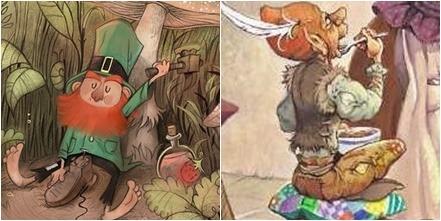
Leprechaun: Leprechaun (Leprecaum) é um pequeno homem barbudo, vestindo casaco e chapéu, que faz travessuras. Eles geralmente são sapateiros que têm um pote de ouro escondido no final do arco-íris.
Brownie: Brownie (Brauni) é um espírito doméstico que ajuda nas tarefas da casa. Eles s�� trabalham à noite, às vezes em troca de pequenos presentes ou comida (gostam de mingau e mel). Os Brownies geralmente abandonam a casa se seus presentes são chamados de pagamento, ou se os donos da casa abusam deles.
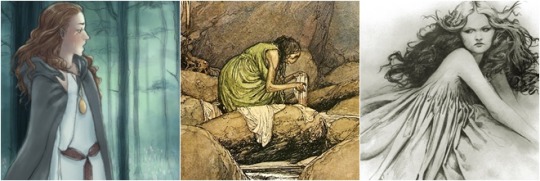
Banshee: Banshee (Banxi) é um espírito feminino bondoso cujo lamento triste à noite prevê a morte de um membro da família daqueles que a ouvem. Seu lamento soa como um grito agudo e seu nome significa "mulher da colina sobrenatural".
Bean nighe: Bean nighe (Bin nai) é um espírito feminino mensageiro do Outro Mundo. Ela é uma espécie de banshee que assombra riachos e lava a roupa daqueles que estão prestes a morrer. Seu nome significa "lavadeira" e em francês são conhecidas como Les Lavandières.
Leanan sidhe: Leanan sidhe (Lienan xi) é uma bela musa que oferece inspiração a um artista em troca de seu amor e devoção, no entanto, isso frequentemente resulta em loucura e morte prematura para o artista. W. B. Yeats popularizou esses espíritos em um poema.
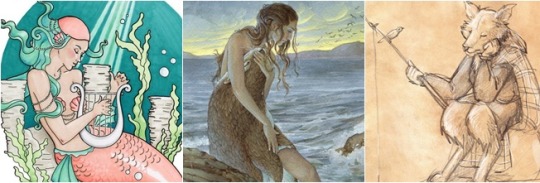
Merrow: Merrow (Mérou) é a sereia do folclore irlandês. Inofensivas, gentis e ingênuas, as merrows precisam de um chapéu mágico para viajar entre águas profundas e terra seca.
Selkie: Selkie (Séuqui) é uma criatura tímida que vive como foca no mar e se torna humana em terra, quando tira sua pele. Se alguém esconde a pele de foca de uma selkie, ela é forçada a viver com essa pessoa até que encontre sua pele novamente e escape para o mar.
Wulver: Wulver (Uulver) é uma criatura parecida com uma pessoa peluda com a cabeça de lobo. Eles são amigáveis com os moradores locais e são conhecidos por deixar peixes no peitoril da janela de pessoas pobres.

Cat sidhe: Cat Sidhe (Quét xi) é um gato fantasma grande como um cão e preto com uma mancha branca no peito que às vezes anda sobre suas patas traseiras. O cat sidhe pode ter sido inspirado no gato de Kellas (um híbrido de gatos selvagens com gatos domésticos encontrado apenas na Escócia).
Cu sith: Cu Sith (Cú xi) é um cão encantado aproximadamente do tamanho de um cavalo e que tem a cauda trançada. Seu latido é tão alto que pode ser ouvido por navios no mar.
Púca: Púca é um metamorfo que geralmente assume a forma de um cavalo, mas também pode aparecer como cão, coelho, cabra ou duende. Ele é conhecido por dar conselhos e afastar as pessoas do perigo.
Unicórnio: O unicórnio é um cavalo com um único chifre pontiagudo em sua testa. É uma criatura selvagem, símbolo de pureza e graça. Na heráldica, o unicórnio é mais conhecido como o símbolo da Escócia.
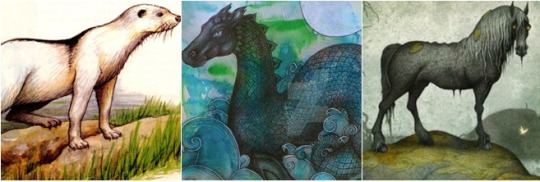
Dobhar-Chú: O Dobhar-chú (Doár-Cú) é uma criatura hibrida de cão e lontra que vive na água e tem pelos com propriedades protetoras.
Nessie: Nessie (Néssi) também conhecido como o Monstro do Lago Ness, é uma criatura que habita o Lago Ness nas Terras Altas da Escócia. É frequentemente descrito como grande, de pescoço comprido e com uma ou mais corcovas.
Kelpie: Kelpie (Quéupi) é um cavalo mágico que habita lagos da Irlanda e Escócia. É geralmente descrito como um cavalo preto capaz de adotar a forma humana. Na Escócia há uma escultura de duas cabeças de cavalo de 30 metros de altura chamada Os Kelpies.
#celtas#mitologia#mitologia irlandesa#mitologia escocesa#mitologia celta#leprechaun#brownie#banshee#bean nighe#leanan sidhe#merrow#selkie#wulver#cat sidhe#cu sith#puca#unicornio#dobhar-chu#nessie#kelpie
4 notes
·
View notes
Text
begging genshin to use diacritics/accents whatever the fuck please god it hurts me to see dobhar chú be writte like that
2 notes
·
View notes
Text

I pulled 53 prints (46 on paper, 7 on totes) by hand today... ouch lol
#traditional art#linocut#relief print#printmaking#you may recognize these prints from Hound Ledger :)#if you cant read the labels the dogs are dobhar-chú; tiagou; church grim; sirius; and the white thing#the white thing is my dead great+ aunt whose mythology got mixed with wolves somehow so now i think of her as a werewolf ghost#and the shrimps are neocaridina davidi (cherry shrimp) and caridina cantonensis (bee shrimp)#im taking these to a festival tomorrow.. i hope they sell#if i sell 15 of the dog prints I could afford to buy the smallest woodzilla press uhu... i would like that very much
49 notes
·
View notes
Text
Dobhar-chú
Alias: Water Hound (translation); King Otter; Irish Crocodile
Place of Origin: Ireland
Habitat: Fresh Water
Grouping: Semi-aquatic mammal
A species rather than a singular being, the Dobhar-chú is said to be large otter-dog hybrid with reported sizes varying from 6 to 15 feet.
Predatory towards humans and animals, it hunts by attempting to drag them into the water to consume or even pursuing them onto land. The Dobhar-chú is most commonly encountered in pairs, should one of the two die, it will let out a high-pitched whistle that alerts the other, its mate will then try to avenge its by killing whoever was the cause of the creatures death.
Sightings:
Sightings of the Dobhar-chú date back as far as 1684.
1722:
A woman named Grace or Grainne Connelly is said to have been killed by a Dobhar-chú while washing clothes, her husband finding her dead body with the Dobhar-chú still upon her. He proceeds to kill the creature that proceeded to alert its mate which chases him for several miles before he manages to succesfully kill it.
This account is backed up by the actual existince of Grace or Grainne Connellys tombstone which depicts a creature not dissimilar to the Dobhar-chú being stabbed.
1896:
One record is by a Miss Walkington, in the 1896 edition of The Journal of Royal Society of Antiquaries of Ireland. She described it as "half-wolfdog and half-fish".
2003:
An Irish artist and his wife claimed to have seen a Dobhar-chú in a lake on Omey Island. Saying they saw a large creature that was able to swim at rapid speed with the help of webbed feet and emmited strange, high-pitched whistle.

31 notes
·
View notes
Text
Monster Hunter fanmade designs part 1/3! I had the idea of sketching a monster for each European Union member state. Given that lands & monsters of The Kingdom, and Elgado Outpost, in Sunbreak are based on European folklore, I can picture them fitting in there. I tried to avoid any designs overly similar to the Three Lords, though there's probably some shared motifs.
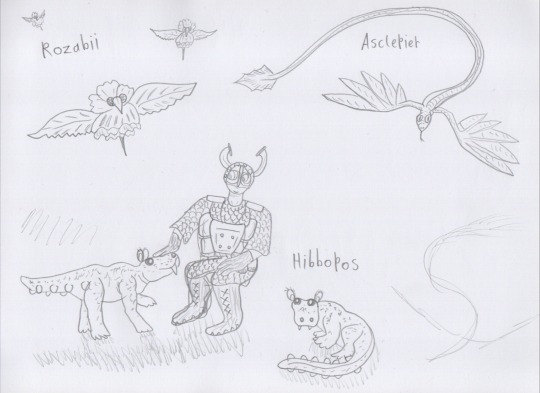
Small monsters. Hibboppos is based on the Cypriot dwarf hippopotamus (Hippopotamus minor, formerly Phanourios minor), Asclepier is based on the medical symbol known as an asklepius, Rozabii is... a rose & a bee.
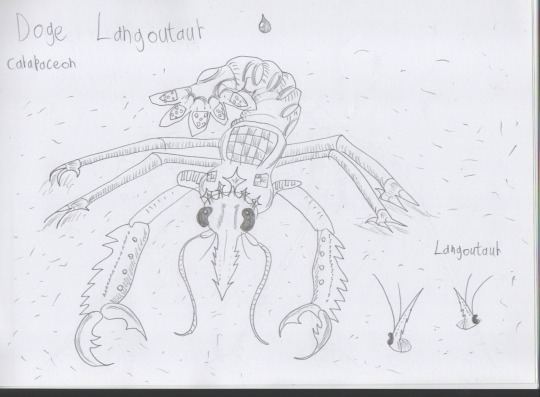
🇵🇹 Doge, Duke and Duce, used as noble or military titles in medieval to modern Europe, derive from the Latin Dux (General). Doge Langoutaur is an early-game monster comparable to a mix of Daimyo Hermitaur and Seltas. Considered a delicacy in many villages.

🇵🇱 An impoverished family who could not afford to decorate their Christmas tree woke on the 25th of December to find that a spider had covered the conifer with webbing while they slept, which now shone silver with morning dew. Thus came the legend of the yule spider and the invention of tinsel. Only in this case, she's using her silk to inflict iceblight. Bring some Nulberries.

🇸🇪 It's said that a Kalmogoth can kill with its breath alone. This is surely an exaggeration, although it smells so stomach-turningly foul it's easy to see how people reached that conclusion. It's hard to stomach a potion when you feel like retching, so watch out for the reach of his long, slimy tail.

🇩🇰 Fenrogaron is a toned down version of Odogaron and Lunagaron, with a fairly basic attack pattern and no element, but he has one trick up his sleeve. Like Gypceros, he'll play dead and wait for unwary foes to approach, before leaping up to clamp his jaws on them.

🇫🇮 Rounding out the Nordics is Saunoth, a remarkably chill amphibian that really just wants to be left alone. Inhabiting remote marshes and fens, it superheats its body with a specialised organ, seemingly with no ill effects. This causes the scummy water it wallows in to boil and bubble like a cauldron, sometimes overflowing its banks in a sulphur-smelling wave. Capable of inflicting fireblight, waterblight and bubbleblight, it is not to be underestimated, despite its sleepy temperament.

🇮🇪 Ah, my fair green country. The legend of Cú Chulainn is well known, but I also wanted to work a different hound into this design; the semiaquatic, pair-bonding Dobhar-chú. Though rather hapless on land, it is remarkably swift in water, and once blood is spilled it will lose all notions of self-preservation in favour of feeding.

🇧🇬 The sweet-smelling sovereign of the hive, the Rozabii Queen is a venomous and thorny, capable even of taking on small wyverns. Despite the danger, hunters seek out hives of this monarch to plunder her most precious treasure - a delicious, chewy, rose-scented plant gum called lokum that is a prized trade commodity.

🇭🇺 Unusually for a fanged wyvern, the Szábray is herbivorous, but never make the mistake of assuming her harmless. Fast, powerful and bad-tempered, she won't hesitate to run down any threat she can smell. Her hooves, horn, claws and tail make swift work of most enemies. Throughout history, domestication has been attempted to create the most imposing of steeds, but wyverns don't breed well in captivity and pose a danger most of all to their rider.
Unless you're in Monster Hunter Stories.

🇭🇷 A mischievous, inquisitive and quite frankly annoying wyvern that scales pine trees in the blink of an eye and rains down incendiary quills, igniting brief but intense blazes that stop pursuers in their tracks. Anyone who braves this assault and fells the pest is rewarded with a pelt so soft and fine that, once carefully stripped of its barbs, it is considered attire fit for a king.
#monster hunter#Portugal#Poland#Sweden#Denmark#Finland#Ireland#Bulgaria#Hungary#Croatia#creature design#mh fanmade monsters#monster design#carapaceon#temnoceran#piscine wyvern#fanged wyvern#amphibian#creature art#traditional art
7 notes
·
View notes